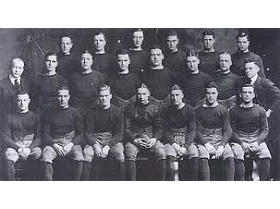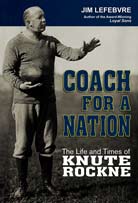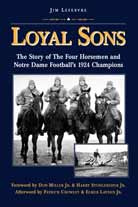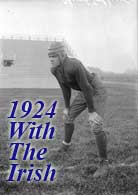A century ago today, on Nov. 27, 1919, Notre Dame won a Thanksgiving Day football game on a snowy, wind-swept field in Sioux City, Iowa, to complete a 9-0-0 season, setting the mark for the best record in the school’s 30-year football history.
One year earlier, Knute Rockne had taken over the reins as ND’s athletic director and head football coach. But it was a season unlike any other, deeply curtailed by the Great War in Europe and the epidemic of Spanish influenza that swept the world. Travel was restricted, games were postponed, re-scheduled, cancelled. Finally, Rockne’s team was able to play a few games in November, finishing with a mark of 3-1-2.
In 1919, with the war over (and several veterans back on campus ready to play some football), Rockne was able to put together a nine-game schedule that would properly test his squad, led by all-around star halfback George Gipp.
Rock’s men opened 1919 with home victories over Kalamazoo College (14-0) and Mount Union College (60-7) before traveling to Lincoln, Nebraska, where they edged the Cornhuskers, 14-9, before a record crowd of 10,000 onlookers on Nebraska Field.
The first four Saturdays of November, 1919, brought victories against big-name opponents. First was a 16-3 dispatching of the Indiana Hoosiers on a muddy field in Indianapolis. The annual journey to West Point, N.Y., resulted in a 12-9 victory. Gipp scored the first TD against Army; Wally Miller – the third of five Miller brothers from Defiance, Ohio, to play for Notre Dame — drove over for the winning score.
Notre Dame closed out the home portion of its schedule with a 13-0 victory over Michigan Agricultural College (today’s Michigan State) before 5,000 fans at Cartier Field. On Nov. 22, Gipp and company traveled to West Lafayette, Ind., and trounced Purdue, 33-13.
Now, all that stood between Rock’s men and a perfect season were the Maroon Chiefs of Morningside College, who would host Notre Dame on Thanksgiving Day at their campus in Sioux City, in northwestern Iowa along the Missouri River. Morningside was founded by the Methodist church in 1894, and under eight-year head coach Jason “Saundy” Saunderson, had developed a quite-successful football program. Like so many coaches across the Midwest and nation, Saunderson had become friends with Rockne, to the point where he was able to get Notre Dame to visit for games not once, but twice.
The two-game series had started two years earlier, in 1917, the final season Rockne had been assistant coach to Jess Harper (though, in effect, a co-coach). Just a week after the long trip to West Point, and a 7-2 victory over Army, Notre Dame had to travel the opposite direction to Sioux City.
Morningside had rolled over three weak opponents by a count of 174-7, and the previous season had battled South Dakota to a scoreless tie and lost only 7-0 to Iowa A&M (today’s Iowa State). Still, Notre Dame was a heavy favorite, and when Gipp circled right end on the first play from scrimmage, it looked like it could be the first of many scores. But before he could reach the end zone, Gipp was knocked out of bounds by two Morningside players and went crashing into a steel fence post that had been temporarily erected for the game.
Gipp winced in pain as he lay on the ground, his ankle broken. Horace Wulf, one of the players who hit him, said, “I’m sorry, boy. I hope it isn’t bad.” To which Gipp replied, “Forget it, pal. You had to come in. It’s all in the game.” Gipp spent the next 11 days in Sioux City’s St. Vincent Hospital, missing the final two games of 1917.
And without Gipp, Notre Dame struggled the rest of the day against Morningside. Said one local account: “The game was a royal battle between the two lines. Pitted against men who were used to battering and hammering their opponents, the Maroon line was able to hold its own.”
For the game, Morningside made 15 first downs to ND’s six, and outgained their visitors, 238-145. The result turned on a couple of Irish interceptions, and ND prevailed, 13-0.
Morningside was able to play just twice in the war-and-flu-shortened 1918 season, but was back in business in 1919, and carried a 5-1 mark into the Thanksgiving Day battle in Sioux City.
But the story became not the records of either team, but the heavy snowfall, blistering winds and deep chill that greeted the teams and the hearty fans, estimated at as many as 10,000 in the biggest game ever to be played in Sioux City.
Morningside players came out for pre-game warmups wearing gloves – something Notre Dame hadn’t packed. Rockne made a last-minute effort to find some, but all nearby stores were closed for the holiday. (A Morningside player said decades later that Rockne went on to build a colorful story around the situation, describing how the Maroon players started with the gloves, but by game’s end, after countless scrums and pileups, Notre Dame players were wearing them.)
The conditions were making the afternoon miserable for the players. Midway through the third quarter, Gipp ambled over to the sideline and said, “I’m through for the day.”
“Like hell you are,” Rockne snorted. He had just about had enough of his star’s impudence, especially during a game very much in doubt. As in 1917, the Maroons were fiercely battling their more famous guests.
One Sioux City scribe described a series thusly: “By successive end-runs, forward passes, and terrific line-smashing, the Catholics placed the pill on the one-yard line, where the Morningside line made official application for a niche in the hall of fame by holding the visitors and causing them to lose the ball on downs.”
In the end, touchdowns by Gipp and Irish quarterback Joe Brandy held up for a 14-6 victory.
Notre Dame’s season was an unqualified success – 9-0-0, the greatest record the school had ever posted in its three decades of intercollegiate football. The Irish outscored the opposition, 229-47. Winning trips to Lincoln, Indianapolis, West Point, West Lafayette and Sioux City. And accolades for key players including guard Hunk Anderson, end Eddie Anderson, and backs Brandy, Gipp, Miller and Pete Bahan.
“With a record of nine victories and no defeats, Notre Dame ended her regular season with a strong claim to the championship of the West,” the Notre Dame Scholastic concluded.
And while other squads – 9-0-1 Harvard, which finished by defeating Oregon in the Rose Bowl, and Illinois, Big 10 champs at 6-1 (the loss coming against 5-2 Wisconsin) – gained national championship designation, Rockne emphatically put his program on the doorstep of national honors.
Portions of this article first appeared in Coach For A Nation: The Life and Times of Knute Rockne (2013, Great Day Press).







